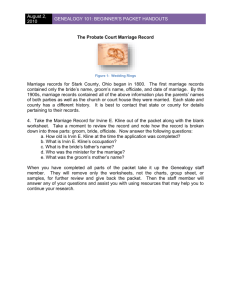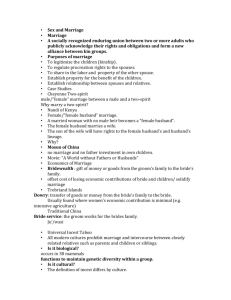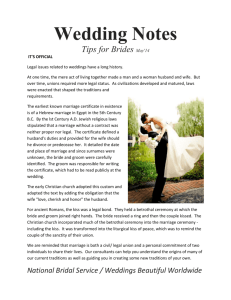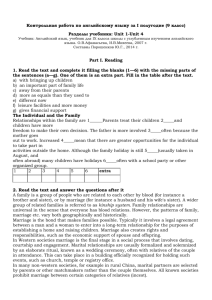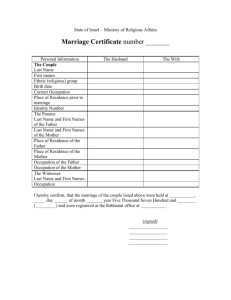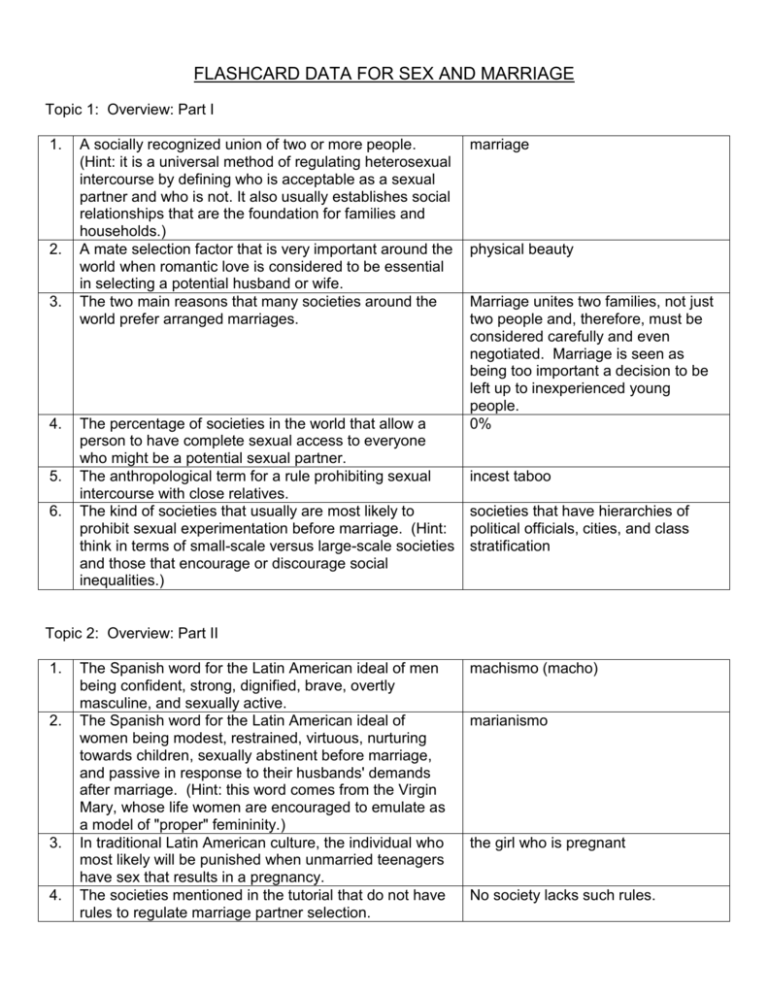
FLASHCARD DATA FOR SEX AND MARRIAGE
Topic 1: Overview: Part I
1.
2.
3.
4.
5.
6.
A socially recognized union of two or more people.
(Hint: it is a universal method of regulating heterosexual
intercourse by defining who is acceptable as a sexual
partner and who is not. It also usually establishes social
relationships that are the foundation for families and
households.)
A mate selection factor that is very important around the
world when romantic love is considered to be essential
in selecting a potential husband or wife.
The two main reasons that many societies around the
world prefer arranged marriages.
The percentage of societies in the world that allow a
person to have complete sexual access to everyone
who might be a potential sexual partner.
The anthropological term for a rule prohibiting sexual
intercourse with close relatives.
The kind of societies that usually are most likely to
prohibit sexual experimentation before marriage. (Hint:
think in terms of small-scale versus large-scale societies
and those that encourage or discourage social
inequalities.)
marriage
physical beauty
Marriage unites two families, not just
two people and, therefore, must be
considered carefully and even
negotiated. Marriage is seen as
being too important a decision to be
left up to inexperienced young
people.
0%
incest taboo
societies that have hierarchies of
political officials, cities, and class
stratification
Topic 2: Overview: Part II
1.
2.
3.
4.
The Spanish word for the Latin American ideal of men
being confident, strong, dignified, brave, overtly
masculine, and sexually active.
The Spanish word for the Latin American ideal of
women being modest, restrained, virtuous, nurturing
towards children, sexually abstinent before marriage,
and passive in response to their husbands' demands
after marriage. (Hint: this word comes from the Virgin
Mary, whose life women are encouraged to emulate as
a model of "proper" femininity.)
In traditional Latin American culture, the individual who
most likely will be punished when unmarried teenagers
have sex that results in a pregnancy.
The societies mentioned in the tutorial that do not have
rules to regulate marriage partner selection.
machismo (macho)
marianismo
the girl who is pregnant
No society lacks such rules.
5.
6.
7.
8.
9.
The common explicit rules in North America defining
who is acceptable to marry. (Hint: explicit rules in North
America and other large-scale societies are usually
formal laws.)
The typical kind of implicit rules in North America
traditionally defining who is acceptable to marry. (Hint:
implicit rules are usually social constraints or
expectations of friends and relatives rather than formal
laws.)
The kinds of societies in which everyone is more likely
to be expected to get married. (Hint: think in terms of
small-scale and large-scale societies.)
The four categories of privileges, rights, and obligations
of a couple getting married that are most often included
in their marriage agreement around the world.
Common methods of preventing pregnancy even in
small-scale isolated societies.
10. The general term for a prohibition against husbands and
wives having sexual intercourse with each other for a
period of time following the birth of their child.
11. The general term for the killing of children.
12. The culture in which people in the distant past were
occasionally forced by winter starvation to kill the
individual within the family who had the least potential
for bringing in food. That was usually the youngest
daughter. She died so that the others could live.
13. The long term negative effect on society of female
infanticide among the Inuit in the distant past.
They must be of the opposite gender,
over the age of consent, willing, alive,
and not a close family member.
They must be within the same social
class, religion, and ethnic/racial
group.
small-scale societies
exclusive sexual access, having and
caring for children, sexual division of
labor, and extending kinship bonds to
your spouse's relatives
not allowing adolescents to marry
(especially boys), magic, abortion,
and post partum sex taboos
post partum sex taboo
infanticide
Inuit (or Eskimo) of the North
American subarctic regions
It reduced the number of
marriageable women, resulting in
increased competition among men for
mates. This has been suggested as
a leading cause of relatively high
murder rates for Inuit men in earlier
times.
Topic 3: Marriage Rules: Part I
1.
2.
The general term for a marriage partner selection rule
requiring that marriage be to someone within a defined
social group such as an extended family, religious
community, economic class, ethnic or age group.
The general term for a marriage partner selection rule
requiring that marriage be with someone outside of a
defined social group such as one's nuclear or extended
family.
endogamy
exogamy
3.
The kind of marriage selection rule that is intended to
prevents incest. (Hint: think in terms of endogamy and
exogamy.)
The kind of marriage selection rule that applies when
relatives tell you that you should marry someone who
speaks your own language and has the same cultural
values. (Hint: think in terms of endogamy and
exogamy.)
The kind of marriage selection rule that applies when
the law says that you cannot marry your sibling or
parent. (Hint: think in terms of endogamy and
exogamy.)
The percentage of the world’s cultures that define at
least some cousins as preferred mates.
The preferred marriage partner among the Bedouin
Arabs. (Hint: it is some kind of cousin.)
exogamy
8.
The preferred marriage partner for a man among the
Yanomamö Indians of Brazil and Venezuela.
a close male friend’s sister (i.e., they
exchange sisters for marriage
partners); in subsequent generations,
this ideally results in cross cousin
marriage
9.
The term for being married to more than one spouse at
the same time.
The term for being married to more than one woman at
the same time.
The term for being married to more than one man at the
same time.
The term for being married to only one spouse at a
time.
The term for being married more than one spouse but
only one at a time.
The form of marriage that was preferred by only 20% of
the sample of 850 societies in the world described in
the tutorial. (Hint: think in terms of polygamy versus
monogamy.)
The form of marriage that most people in the world
follow today. (Hint: think in terms of polygamy and
monogamy.)
polygamy
4.
5.
6.
7.
10.
11.
12.
13.
14.
15.
endogamy
exogamy
about 30%
patrilateral parallel cousin (i.e., a
parallel cousin on the father’s side of
the family)
polygyny
polyandry
monogamy
serial monogamy
monogamy
monogamy
16. The people in Greek villages who traditionally have
been socially prohibited from marrying again after the
death of their spouses. (Hint: think in terms of men and
women.)
17. The rarest form of marriage in the world. (Hint: think in
terms of monogamy, polygyny, and polyandry.)
18. The areas of the world in which polyandry is a culturally
accepted form of marriage.
19. The form of polyandry in which two brothers marry the
same woman.
20. The reason that the introduction of the notion of
romantic love has been disruptive in polyandrous
marriages.
21. The major areas of the world in which polygyny is still a
culturally accepted form of marriage.
women
polyandry
some isolated rural regions of India,
Sri Lanka, Nepal, and Tibet
fraternal polyandry
It encourages the concept of
exclusive bonds with the wife by each
husband.
Moslem nations, traditional cattle
herding societies of East Africa, and
the remnants of the old kingdoms of
West Africa.
Topic 4: Marriage Rules: Part II
1.
The typical sources of disagreements in monogamous
marriages around the world.
2.
The typical sources of disagreements in polygynous
marriages around the world.
3.
The term for the marriage of two or more sisters to the
same time.
The most common source of friction in polyandrous
marriages in the past before the introduction of the idea
of romantic love.
How friction is usually avoided or reduced between the
wives in a polygynous marriage.
4.
5.
6.
The region of the world in which the Nuer live.
7.
A form of marriage among the Nuer in which a man may
marry a woman as a stand-in for his dead brother.
A second marriage rule specifying that a widow should
marry the brother of her dead husband.
The reason for the levirate rule. (Hint: think of the
advantages.)
8.
9.
husband and wife disagreements and
parent-child rivalry for the attention of
the other parent
jealousy between co-wives over
perceived unequal attention from their
shared husband and rivalry between
the children, especially if there is
something important to inherit
sororal polygyny
rivalry between the fathers and their
children for the attention of their
wife/mother
giving each wife a separate house,
ranking the wives in terms of relative
status within the family, and sisters
marrying the same man
East Africa (mostly the southern part
of Sudan)
ghost marriage
levirate
It keeps the dead man's children and
wealth within his family and continues
the bond between the two families of
the married couple despite the death
of the husband.
10. A second marriage rule specifying that a widower
should marry the sister of his dead wife.
11. The reason for the sororate.
12. The term for the sexual permissiveness between a
husband and his wife's younger sister in anticipation of a
presumed future marriage between them. (Hint: this
occurs in societies that have sororal polygyny.)
13. Money or property given by the bride's family to the
groom when a marriage occurs. (Hint: this money is
usually intended to establish a new household or to
provide the bride with her share of the family
inheritance.)
14. The regions of the world in which dowrys have been
traditionally most important.
15. Things of high value given by a groom to his bride's
father. (Hint: this is usually seen as a way of showing
respect for the bride and her parents. At the same time,
it is a compensation for the bride's family for the loss of
her economic services. In addition, it is a way of
validating the groom's right to future offspring. It has
also been called bride wealth and progeny price.)
16. The regions of the world in which bride price has been
traditionally most important.
17. Work or services done by a groom for his wife's family
instead of paying a bride price. (Hint: this service is
usually for a set period of time, often years.)
18. The main reason why in societies that have a
substantial bride price that the bride's family has a
strong interest in keeping her marriage together. (Hint:
think about economic advantages.)
19. The person who usually gets to keep the children when
a divorce occurs in a society that has bride price. (Hint:
think in terms of the husband and wife.)
20
The usual circumstances that lead to marriage by
capture as an alternative method of acquiring a wife.
(Hint: marriage by capture has occurred in Melanesia,
the Amazon Basin of South America, and scattered
elsewhere among warlike peoples.)
sororate
It continues the bond between the
families of the married couple despite
the death of the wife.
anticipatory sororate
dowry
the mostly monogamous societies of
Europe and Asia
bride price
polygynous, small-scale, patrilineal
societies in sub-Saharan Africa and
among Native Americans
bride service
divorce would require the return of
the bride price, which often has
already been given away.
The father usually keeps the children
and the bride price usually does not
have to be returned. He keeps the
children instead of the bride price. In
a sense, the bride price becomes a
payment for children.
when bride price can’t be arranged,
when women are in short supply, or
when the bride’s family will not grant
permission for the marriage even
though the future bride may wish to
marry the man
Topic 5: Residence Rules
1.
2.
3.
4.
5.
The residence pattern in which a newly married couple
moves in with or near the groom's father's house. (Hint:
this is a common residence pattern in societies that
have patrilineal descent.)
The main reason that patrilocal residence is common in
societies that have patrilineal descent.
The residence pattern in which a newly married couple
moves in with or near the bride's mother's house. (Hint:
this a common residence pattern in societies that have
matrilineal descent.)
The main reason that matrilocal residence is common in
societies that have matrilineal descent.
patrilocal residence
It keeps men near their male relatives
from whom they will inherit status,
property, knowledge, and other things
of value.
matrilocal residence
It keeps women near their female
relatives from whom they will inherit
statuses, jobs, or prerogatives.
neolocal residence
The residence pattern in which a married couple
establishes a new residence independent of both their
families. (Hint: this is the most common residence
pattern in North America and other industrialized nations
in which the importance of kinship is minimized. It is
also common in small-scale societies when economic
hardship periodically requires a family to leave the
community and move to a new area in order to find
enough food.)
6. The term for the residence pattern in which a newly
avunculocal
married couple moves in with or near the groom's
maternal uncle's house. (Hint: this residence pattern is
strongly associated with matrilineal descent.)
7. The main rationale for avunculocal residence.
It allows men to live near their
nearest elder matrilineal male relative
from whom they will inherit statuses,
jobs, or prerogatives.
8. A family consisting of a man, woman, and their children. nuclear family
9. The nuclear family in which you are a child.
nuclear family of orientation
10. The nuclear family in which your are a parent.
nuclear family of procreation
11. A family consisting of two or more nuclear families tied
extended family
together by bonds of descent. (Hint: this larger family
usually contains living relatives from three or more
generations.)
12. A family consisting of two or more relatives of the same
generation living together with their respective spouses
and children. (Hint: these rare larger families typically
consist of 1-2 generations.)
13. The kinds of societies that most commonly have
extended, joint, and polygynous family households.
(Hint: big families are economically advantageous in
these kinds of societies because large, permanent labor
groups are needed for the important subsistence
activities.)
14. The kinds of societies that most commonly have nuclear
family households. (Hint: small families are
economically advantages in these kinds of societies
because geographic mobility is necessary.)
15. The term for a nuclear family in which there is no
continuing adult male functioning as a husband and
father. This man is missing usually due to death,
divorce, abandonment, or no marriage having taken
place. In such families, the mother raises her children
more or less alone and subsequently has the major role
in their socialization.
joint family
small-scale farming (horticultural) and
pastoralist societies
foraging societies in marginal
environments where it is usually
necessary to seasonally disperse the
community and large-scale
industrialized societies in which
jobs often require relocation to
another part of the country or the
world from time to time
matricentric (or matrifocused)
Topic 6: Homosexuality
1.
2.
3.
4.
5.
6.
The sexual and/or emotional desire for others of the
same gender as oneself.
The sexual and/or emotional desire for others of the
opposite gender as oneself.
Laws prohibiting anal or oral copulation with another
person or animal. (Hint: the term you are looking for is a
legal one. In modern industrial nations, homosexuals
are the usual target of these laws.)
The regions of the world where there are the most
severe penalties for male homosexuality. (Hint: these
penalties can include death or life in prison.)
The regions of the world where usually only male
homosexuality is criminalized.
A person who wears the clothes and bodily adornment
normally associated with the opposite gender. (Hint:
this is not necessarily connected with homosexuality.)
homosexuality
heterosexuality
anti-sodomy laws
Islamic nations of North Africa, Middle
East, Central and South Asia
South Pacific Islands, the non-Islamic
nations of Africa, and some
Caribbean Islands on which a high
percentage of the population has
Sub-Saharan African ancestral roots
transvestite
7.
8.
9.
10.
11.
12.
13.
A term used to refer to North American Indian
homosexual men of the Great Plains and elsewhere in
Western North America. In the past, these “two-spirited”
men led their lives as transvestites and were given
respected social statuses within their societies.
A group of culturally accepted (or at least tolerated)
male transvestites in India. Many of these men have
their genital organs surgically removed to symbolize
their transition to "womanhood." They are devotees of
the Hindu mother goddess Bahuchara Mata.
A culture in New Guinea in which all men apparently
engage in homosexual acts and most also marry and
engage in heterosexual acts with their wives. (Hint: in
this culture, heterosexual intercourse is prohibited for up
to 260 days of the year and is forbidden in or near their
houses and vegetable gardens. In contrast,
homosexual relations are permitted at any time.)
The common attitude towards homosexuality in
societies that strongly forbid abortion and infanticide.
The common attitude towards homosexuality in
societies that have severe food shortages resulting from
over population.
The characteristic of having a blend of both masculine
and feminine personality characteristics but not strongly
either one.
The modern term used by many Native Americans for
berdache.
berdache
Hijras
Etoro
They are usually intolerant of
homosexuality.
They are usually tolerant of
homosexuality.
androgynous
two-spirted
Copyright © 2007 by Dennis O'Neil. All rights reserved.




